Three recent studies reveal just how important top predators are to their ecosystems.
Few species have faced such vitriolic hatred from humans as the world’s top predators. Considered by many as pests—often as dangerous—they have been gunned down, poisoned, speared, ‘finned’, and decimated across their habitats. Even where large areas of habitat are protected, the one thing that is often missing are top predators.
However, new research over the past few decades is showing just how vital these predators are to ecosystems. Biologists have long known that predators control populations of prey animals, but new studies show that they may do much more. From controlling smaller predators to protecting river banks from erosion to providing nutrient hotspots, it appears that top predators are indispensable to a working ecosystem.
Not easy being a top predator
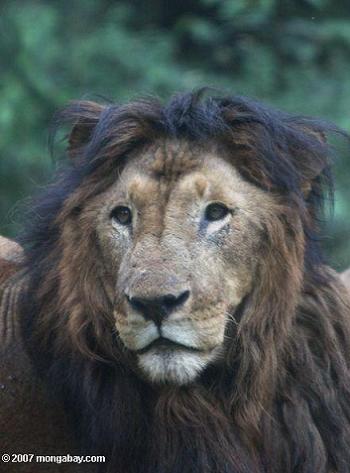 Male lion in Kenya. Photo by: Rhett A. Butler. |
Top predators sit at the apex of an ecosystem’s food chain. Wolves in Alaska, tigers in Siberia, lions in Kenya, white sharks in the Pacific are all examples of top predators. Some top predators have been introduced by humans, such as dingos in Australia, while others have taken over after humans have extirpated the ecosystem’s natural top predators, such as coyotes in the US after wolves and mountain lions vanished. Either way, the expanse and population of top predators has changed drastically as humans have taken over the world.
In the continental United States genetic evidence shows that there were once 200,000 wolves when Europeans arrive; today there are less than 5,000. Despite millions of dollars and years of conservation effort wolves are only present in 5 percent of their historic range in the US. Wolverines, though largely a scavenger, are terrific hunters in their own right (they are even known to harass both wolves and mountain lions). But they have it even worse in the US than wolves. While there are only an estimated 500 wolverines in the continental US, the Bush Administration denied them any coverage under the Endangered Species Act stating that wolverines still thrived in Canada, essentially arguing that this predator was unworthy of protection.
The world’s largest cats—tigers—are endangered throughout all of their range. Despite being one of the world’s most recognizable, and beloved, animals, tigers are on the edge of extinction. The species is classified as Endangered by the IUCN Red List, while two of the six surviving subspecies of tiger are considered Critically Endangered. Few animals have received the amount of conservation attention and funds as tigers, yet every year the great cat moves further from a comeback. Recent reports show tiger populations dropping in both India and Russia, both of which were considered the bright spots in tiger conservation.
Even when top predators bring in millions in tourist revenue—such as is the case of lions in Africa—they still face a barrage of trouble. Habitat loss, poisoning, and killing by gun or spear has crippled African lion populations. Recent reports state that they could vanish altogether from some of their best habitat—i.e. Kenya’s grasslands—in twenty years if nothing is done.
To think such species are somehow immune to extinction is erroneous: three tiger subspecies (the Javan, the Bali, and the Caspian), two wolf subspecies (both from Japan), one lion subspecies (the Barbary), and the thylacine—once apex carnivore in Australia—all vanished during the 20th Century. This past decade has seen the loss of the baiji: top predator and river dolphin of China’s Yangtze River.
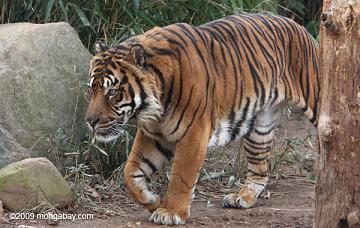 The Critically Endangered Sumatran tiger in captivity. Photo by: Rhett A. Butler. |
Other top predators linger on the edge of extinction: the Amur leopard, the Indo-Chinese tiger, the Arabian leopard, the Javan leopard, and the Asiatic cheetah could all vanish during this century. In some parts of the world populations of large mammalian carnivores have dropped a staggering 95-99 percent.
It’s not just on land where top predators are vanishing. In the oceans, many shark populations have been decimated. Overfishing, by-catch, and ‘finning’ (whereby fishermen cut off a shark’s fin and then dump the animal back in the water, where it soon succumbs) are all taking a toll on some shark species. A study in 2006 found that up to 73 million sharks are killed by fining in a single year—all this to keep up orders of the Asian delicacy: shark fin soup. The first global survey of sharks and rays found that nearly one-in-three species are threatened with extinction, higher even than amphibians, which are said to be in the midst of an extinction crisis. Some shark species populations have plummeted by over 90 percent in just a few decades.
At a time when top predators are vanishing worldwide, three recent research papers show a very new side of top predators. Peeling off the dangerous, fierce veneer, these studies show that top predators are actually protectors of many aspects of the ecosystems they inhabit and show just how many detrimental ecological ripples their losses entail.
‘My enemies’ enemy is my friend’
It has long been known that top predators affect and control populations of prey species (such as wolves and elk, lion and zebra, tigers and deer), but recent studies have shown that top predators also affect carnivorous species just one rung beneath them on the food chain, known as mesopredators. Coyotes in North America, hyenas in Africa, ocelots and jaguarundis in South America, and weasels in Europe are all examples of mesopredators.
The rest of this article is now only available to subscribers. An updated version is also published in Jeremy Hance’s book, Life is Good: Conservation in an Age of Mass Extinction, which was released in January 2012.
Citations: Euan G. Ritchie and Christopher N. Johnson. Predator interactions, mesopredator release and biodiversity conservation. Ecology Letters. Volume 12, Issue 9.
Beschta, R.L. and W.J. Ripple. Large predators and trophic cascades in terrestrial ecosystems on the western United States. Bological Conservation.
Bump, J.K., Peterson, R.O., & Vucetich, J.A. 2009. Wolves modulate soil nutrient heterogeneity and foliar nitrogen by configuring the distribution of ungulate carcasses. Ecology. Vol 90, Issue 11.
Related articles
Indonesia plans to sell endangered tigers as pets to the wealthy
(01/21/2010) Indonesia has a new plan to save the Critically Endangered Sumatran tiger, reports the AFP: sell captive-born tigers as pets. The proposed price is 100,000 US dollars for a pair of Sumatran tigers with the money going to conservation efforts, though it was unclear who would manage these funds.
Over 15 percent of Florida panther population lost last year due to car collisions
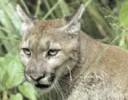
(01/07/2010) A record number of endangered Florida panthers died this year due to car collisions, reports conservation organization, Defenders of Wildlife. Sixteen panther deaths from cars have been confirmed in 2009; an additional animal is suspected of having died from injuries due to a car in October. The mortality rate due to cars alone depletes the Florida panther population by over 15 percent. With less than 100 individuals left in the wild, every Florida panther killed before its time makes it more difficult for the animal to recover.
Starving hyenas kill and eat 12-foot-long python during drought
(01/05/2010) Members with the conservation group Lion Guardians stumbled on a rare site in the Amboseli area of Kenya recently: six hyenas and a number of jackals were attacking and eating a 12-foot-long python. On their blog at WildlifeDirect, Lion Guardians describe the attack: “[the hyenas and jackals] tore into its body from the back, and were taking their share while the upper part of the python was still alive! The Lion Guardian team was shocked and surprised at the same time, having never seen anything like it before.”
Gone: a look at extinction over the past decade

(01/03/2010) No one can say with any certainty how many species went extinct from 2000-2009. Because no one knows if the world’s species number 3 million or 30 million, it is impossible to guess how many known species—let alone unknown—may have vanished recently. Species in tropical forests and the world’s oceans are notoriously under-surveyed leaving gaping holes where species can vanish taking all of their secrets—even knowledge of their existence—with them.
Hyenas cooperate more easily than chimpanzees
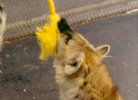
(12/06/2009) Spotted hyenas (Crocuta crocuta) could show chimpanzees a thing or two about working together, according to a new study. Hyenas, prodigious hunters, pull down prey together. Christine M. Drea, an associate professor in the department of Evolutionary Biology at Duke University, started to ask questions about the cooperative hunting habits of hyenas while she was reading The Spotted Hyena: A Study of Predation and Social Behavior by Hanz Kruuk.
Prime Minister of Kenya urged to ban lion-killing pesticide after child dies from ingestion
(11/10/2009) On Monday October 26th a three-year-old girl mistakenly ate the pesticide Furadan (also known as carbofuran) in western Kenya. Her father, a teacher at a primary school, said that he had no knowledge of how dangerous the pesticide was, which he had purchased to kill pests in his vegetable garden.
Saving the world’s rarest wolf

(11/09/2009) Living on the roof of Africa, the Ethiopian wolf is one of the world’s rarest carnivores, if not the rarest! Trapped on a few mountain islands rising over 4,000 meters above sea level on either/both sides of the Great Rift Valley, this unique canid has so far survived millennia of human-animal interactions in one of Africa’s most densely populated rural lands. But the threat of climate change and a shifting agriculture frontier may require new conservation measures, according to Argentine-born Claudio Sillero, the world’s foremost expert on the Ethiopian wolf, who has spent two decades championing this rare species.
World’s first video of the elusive and endangered bay cat

(11/05/2009) Rare, elusive, and endangered by habitat loss, the bay cat is one of the world’s least studied wild cats. Several specimens of the cat were collected in the 19th and 20th Century, but a living cat wasn’t even photographed until 1998. Now, researchers in Sabah, Malaysian Borneo, have managed to capture the first film of the bay cat (Catopuma badia). Lasting seven seconds, the video shows the distinctly reddish-brown cat in its habitat.
Photos: Palm oil threatens Borneo’s rarest cats

(11/04/2009) Oil palm expansion is threatening Borneo’s rarest wild cats, reports a new study based on three years of fieldwork and more than 17,000 camera trap nights. Studying cats in five locations—each with different environments—in Sabah, Malaysian Borneo, researchers found that four of five cat species are threatened by habitat loss due to palm oil plantations. “No other place has a higher percentage of threatened wild cats!” Jim Sanderson, an expert on the world’s small cats, told Mongabay.com. Pointing out that 80 percent of Borneo’s cats face extinction, Sanderson said that “not one of these wild cats poses a direct threat to humans.”
Wolves keep forests nutrient-rich
(11/02/2009) As hunting wolves is legal again in two American states, Montana and Idaho, researchers have discovered an important role these large predators play in creating nutrient hotspots in northern forest environments. Researchers from Michigan Technological University found that when wolves take down their prey—in this case moose—they do more than simply keep a check on herbivore populations. The corpses of wolf-hunted moose create hotspots of forest fertility by enriching the soil with biochemicals. Due to this sudden up-tick in nutrients, microbial and fungal growth explodes, in turn providing extra nutrients for plants near the kill.
Tsavo lions ate 35 people, not 135

(11/02/2009) A recent study in the Proceedings of the National Academy of Sciences has shown that the two man-killing lions of Tsavo very likely did not kill and eat as many people as claimed. Looking at hair and bone samples from the pair of male lions, now resting in the Chicago Field Museum, researchers were able to determine that the Tsavo lions likely killed and ate approximately 35 people, not 135 as claimed by Lieutenant Colonel John H. Patterson. Patterson became famous for shooting and killing the lions in December 1898. For nine months the two lions terrorized a railroad camp in Kenya.
Tiger rescued from poachers in Malaysia perishes from injuries
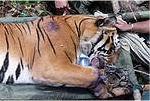
(10/29/2009) Rescued in early October from a poacher’s snare, a Malayan tiger has died from stress and infection due to its injuries. The 120 kilogram (264 pound) male tiger died on October 19th in the Malacca Zoo after undergoing surgery to amputate its right foreleg, which two weeks before had been caught in a poacher’s snare and severely injured. “It broke my heart as I was there during the rescue. Everyone had such high hopes of the tiger being released back into the wild after its treatment at the zoo, and no one spoke of the in-betweens,” says Reuben Clements.
Kenya’s pain, part two: decades of wildlife decline exacerbated by drought

(10/20/2009) Not many years ago if you were planning a trip to Africa to see wildlife, Kenya would be near the top of the list, if not number one. Then violent riots in late 2007 and early 2008 leaving a thousand dead tarnished the country’s image abroad. When calm and stability returned, Kenya was again open for tourism, and it’s true that most travelers were quick to forget: articles earlier this year announced that even with the global economic crisis Kenya was expecting tourism growth. However, a new disaster may not be so quickly overcome.
Tiger success story turns bleak: poachers decimating great cats in Siberia

(10/18/2009) There were two bright spots in tiger conservation, India and Russia, but both have dimmed. Last year India announced that a new survey found only 1,411 tigers, instead of the previous estimation of 3,508, and now Russian tigers may be suffering a similar decline. The Siberian Tiger Monitoring Program—a collaboration between the Wildlife Conservation Society (WCS) and several Russia government organizations—has found evidence that after a decade of stability the Siberian tiger’s population may be falling. This year’s annual survey, which covers only a portion of tiger habitat in Russia, found only 56 adult tigers: a forty percent decrease from the average of 95 tigers. While the cause of this year’s decline may be weather-related, researchers fear something far more insidious is going on.
Uganda to open its doors to big game hunters
(10/15/2009) Uganda, which suffered a 90 percent decline in large mammals during the 70s and 80s, has now lifted a decades-long ban on big game hunting, reports the AFP.